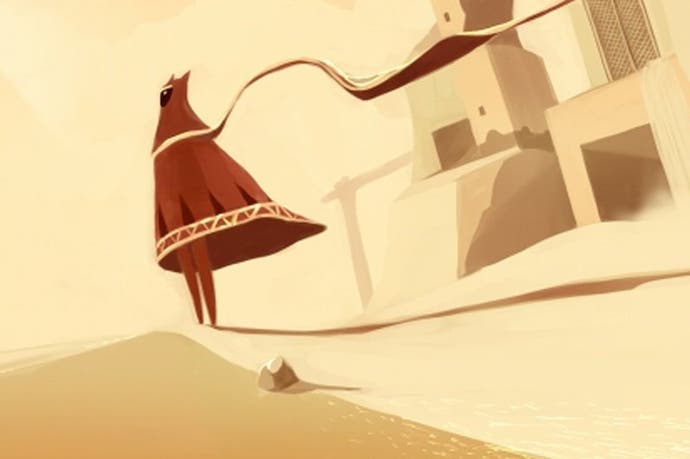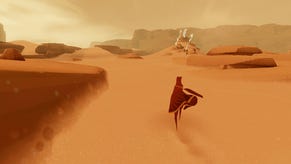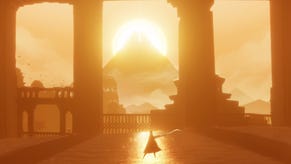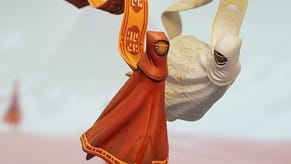Face-Off: Journey on PS4
Improved gameplay vs PS3, but has the remaster compromised thatgamecompany's original vision?
Journey. Perhaps the perfect word to define the trajectory of this particularly elusive PlayStation 4 remaster. Having briefly spent time with the game just last year at Gamescom, performance was solid enough that it seemed likely that a full release would follow shortly thereafter. Instead, nothing. Outside of the odd blog post, this particular port remained shrouded in mystery throughout most of its development cycle. Now, three and a half years after its original last-gen release, Journey has finally emerged on PlayStation 4.
Its technological underpinnings are based on an advanced iteration of PhyreEngine - a modular, cross-platform, free to license graphics engine created by Sony Computer Entertainment. It's an engine which thatgamecompany, creator of Journey, previously used in each of its PlayStation 3 projects. With its complex sand rendering, dust effects, and fluid simulation, Journey made extensive use of the PS3's SPUs to bring its world to life. With a small development house known as Tricky Pixels tackling this PS4 port, we were genuinely curious to see how this ambitious project would translate to Sony's latest console platform.
At first glance, this PS4 iteration appears to fully retain the beauty of the original game. The simple, clean designs, attractive lighting, and lovely sand simulation return alongside a nice bump in performance and image quality. Even better, it's available for free to owners of the original game thanks to the CrossBuy feature - if you bought the original and upgraded to PS4 in the meanwhile, the new remaster is sitting in your download list right now, just as it was for. We finished the remastered version of the game in one sitting and have to say that the experience was just as wonderful as we had remembered. However, upon closer inspection, we began to notice some rather subtle changes, suggesting a conversion scenario that was less straightforward than you might imagine.
Previously, Journey has been confirmed as featuring a 1080p presentation, but overall image quality is a little strange. The selected method of anti-aliasing is actually less effective than the technique used on the original PS3 game; pixel density has increased, but pixels tend to shimmer more during gameplay. There's also a number of soft edges throughout, giving the impression of a lower resolution - pixel-counting throws up a wide variance in potential resolution measurements, sometimes sub-native, occasionally above native resolution. Occasionally it seems as if we can see super-sampling on the horizontal axis and upscaling on the vertical. It may well be down to the effects of the post-processing pipeline, but overall it doesn't quite look like the 1080p presentation we would expect. Fortunately, the strong design work manages to side-step these issues for the most part. In-surface aliasing isn't an issue and temporal instability is kept to a minimum. Anisotropic filtering is also engaged to a reasonable degree though it only becomes observable on select surfaces such as flowing scarves.
Much to our surprise, certain visual effects have been removed or diminished in this new version of Journey, sapping away just a touch of the visual perfection that came to define the original game. Motion blur, which is beautifully utilised on PS3, has been completely eliminated, which has a small impact on the presentation: speeding along the sun-drenched slopes feels a tad less dramatic without this effect in place. It's likely that Trick Pixels felt that at 60fps, motion blur was no longer a necessity. We disagree and feel that even at higher frame-rates, motion blur can add greatly to the presentation.
This extends to lighting and effects as well. Sand simulation is a critical element in the presentation of the game. Created from a juxtaposition consisting of three height-map layers and textures designed to simulate millions of little 'mirrors', the original design successfully forms the illusion of a vast body of reactive sand stretched out before the player. This glittering sand effect is now reduced significantly. In the original version, you'll notice sparkling grains of sand present throughout many scenes, while the effect is often absent on PS4, resulting in a flatter overall presentation. The sand in general appears to lack the coarseness that is so evident on PS3.
There are also subtle differences in lighting - in one scene, the visible clouds on PS3 are completely obscured by light bloom on PS4. In another, the low-hanging sun peeking around a distant structure in the original game becomes less visible in the PS4 port. These are small details to be sure, but quite why there is a difference at all remains a mystery.

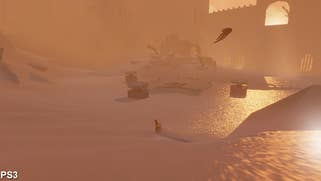
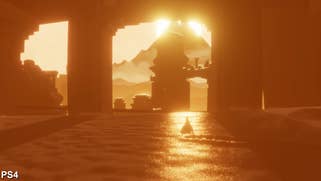

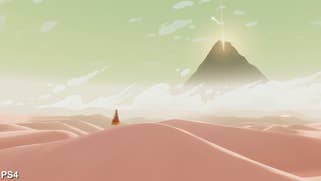
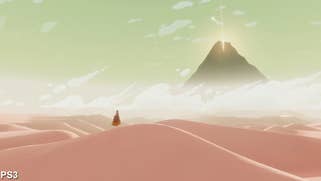


This may seem like nitpicking really, but the extreme care and attention that originally went into Journey's original creation on PS3 shouldn't be under-estimated. Every single visual effect feels as if it were used with a purpose, nothing ever feels out of place and every second of the game feels hand-crafted. When you start cutting back some of the details, no matter how small they may be, the end result is that Journey's original identity feels somehow eroded. This is a game that many view as a work of interactive art - and tampering with it somehow feels wrong.
Thankfully, there are some genuine improvements in here. Performance-wise, Journey for PS4 now operates at a fluid 60 frames per second, greatly enhancing the sensation of player movement throughout the game. As a rather short experience, we were able to play through the entire game on PS4 enabling us to pass judgement on performance as a whole. By and large, we're looking at a completely stable 60fps, but it isn't quite as flawless as we had anticipated. Three specific areas in the game exhibit very minor slowdown: performance never dips lower than 55fps and while it's unlikely that most players will even notice the issue, it's worth noting its existence nonetheless.
Multiplayer features are handled just as seamlessly as the original. Players weave in and out of the world with nary a pause while the unique method of communication continues to delight. It's not clear if the game shares its player base between the two consoles. While testing on PlayStation 3 we were actually surprised to find people still enjoying the original version. Neither version of the game seemed to exhibit any issues while pairing players together. Journey doesn't exactly push the boundaries of online multiplayer from a technological perspective, but as we've seen all too often this generation, QA issues both big and small can impact on the overall polish of a game.
Journey on PS4 - the Digital Foundry verdict
Taken on its own as a standalone product, Journey on PS4 is an immensely polished experience from top to bottom. The visual design and fluidity of the experience rival the quality you might expect from one of Nintendo's top-tier development teams. The game is simply a joy to play and the faster input response coupled with higher performance really draws you into the world, to the point where a return visit after playing on PS3 remains a remarkable experience. Journey feels like a perfect blend of lofty artistic aspirations combined with the sensibility of classic game design. The purist fan may find some of the minor visual changes disappointing but these differences really only become evident when the two versions are placed side-by-side.
However, this does bring to light an interesting consideration when discussing "games as art" - particularly where Journey is concerned. When film grain is expunged from a Blu-ray release of a classic film there is an outcry. When a smudge on a famous painting is 'fixed', the repercussions are severe. How does this apply to a game? A video game is not a static work and its code can be modified or restored on a whim. This sort of control over a piece is not something other forms of expression really take advantage of. It's something that separates this medium from traditional works of art - almost like a half-step between a copy of a film and a remake.
Perhaps this ties into the concept of ageing. Unlike a painting or a novel, games and technology are inherently connected. A creative work designed on an older computer is limited in ways that modern games are not, yet these limitations sometimes inspire creativity and push creators to new heights. When updating such a work for a new platform, developers must take special care to maintain its original intent. If you look at a title such as Shadow of the Colossus, which has also received an HD re-release, you can see the brilliance in its original design. It utilised the PlayStation 2 in ways that no other developer had. However, it's still a video game meant to be played and its frame-rate was disappointingly sluggish. It's difficult to imagine the artist's intent including such a low frame-rate. As such, a remaster makes a lot of sense - aspects of the design which were inspired by the original hardware remain intact but unintended flaws can be eliminated. It's a dangerous line and one that requires an expertly guided hand. In comparison, it doesn't really feel as if Journey was held back in any detrimental way on its original platform, and by changing numerous visual elements, the revised vision feels as though it has been needlessly compromised to a certain extent.
Ultimately, Journey is still a video game at its heart. It may evoke a feeling or emotions but it's still a game and, as a game, it plays better on PlayStation 4. There are changes to be sure - and clearly not all of them are for the better - but the experience of playing Journey has not diminished. In fact, it's quite the opposite. Some of the changes and cutbacks don't feel right to us, but in the final analysis, Journey on PS4 plays and runs better than the original and that is - perhaps - the most important element to consider.
UPDATE 26/7/15 4:40pm: Developer Tricky Pixels has posted its response to this article in the comments below that's well worth a read. Here's the post in its entirety:
Just to mention a few things here:
- The removal of the motion blur was intentional and carefully considered. The post process motion blur of the original gave a very different feel at 60FPS. It's difficult to describe but it really detracted from the cinematic style - it just really stuck out as an obvious post process effect at 60. The best way I can describe it is being akin to switching on some of the frame processing on an old movie with a modern LED display - the effect started to make Journey feel like a modern racing title and really compromised the original artist vision. Additionally with the increase to 1080p, a global increase in anisotropic filtering and a reduction in texture compression the game gained a new solidity and clarity - a lot of this got lost when re-enabling motion blur, so we stuck with the much more natural blur from POV at 60.
- One of the compromises made in the original PS3 version was the resolution of the sand texturing, which is procedurally generated. For surfaces near or low to the camera the illusion of sand was often broken by texture magnification - so we opted to use some of the extra power available on PS4 to double the resolution of this system. The result is a finer grained surface (like sand!) at the loss of some of the coarseness you sometimes see in the original. You can see see this improvement most clearly in the open sections of the dune surfing section after 'landing' (level 4).
- Early on in the development process we received a bunch of fan emails asking us to keep various glitches and exploits that people use in the game - nearly all of these have been intentionally kept/replicated to make the game as true to the original as possible.
- This was a non-trival re-master - the original PS3 version of Journey is a master-piece in PS3 Cell/SPU programming and utilized all of the power of the original system. Translating all of this to a new CPU (and GPU) was an immense technical challenge. We'd recommend people read around some of the Naughty Dog articles/posts about their experiences in bringing a late generation PS3 title to PS4 - it really is/was a tough job. There were many thousands of hours of time spent making the re-master as faithful as possible.
